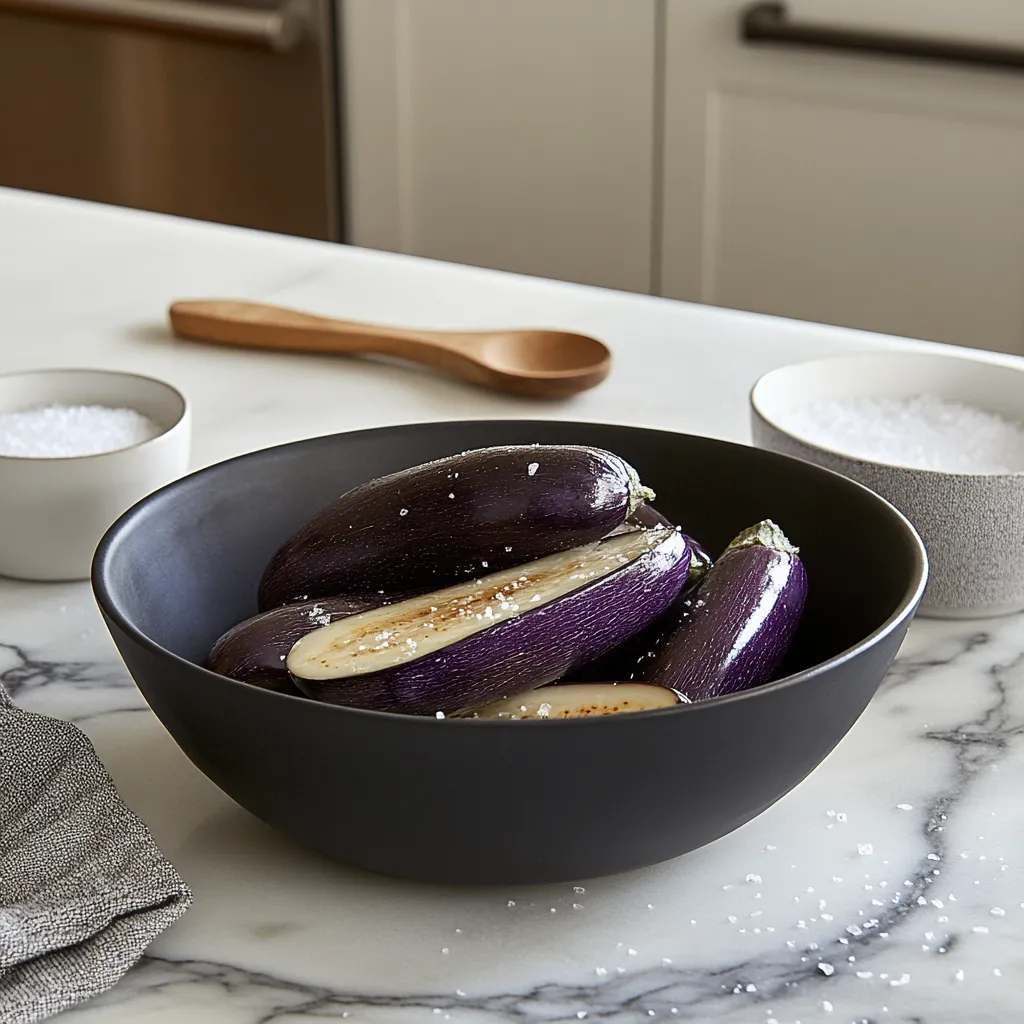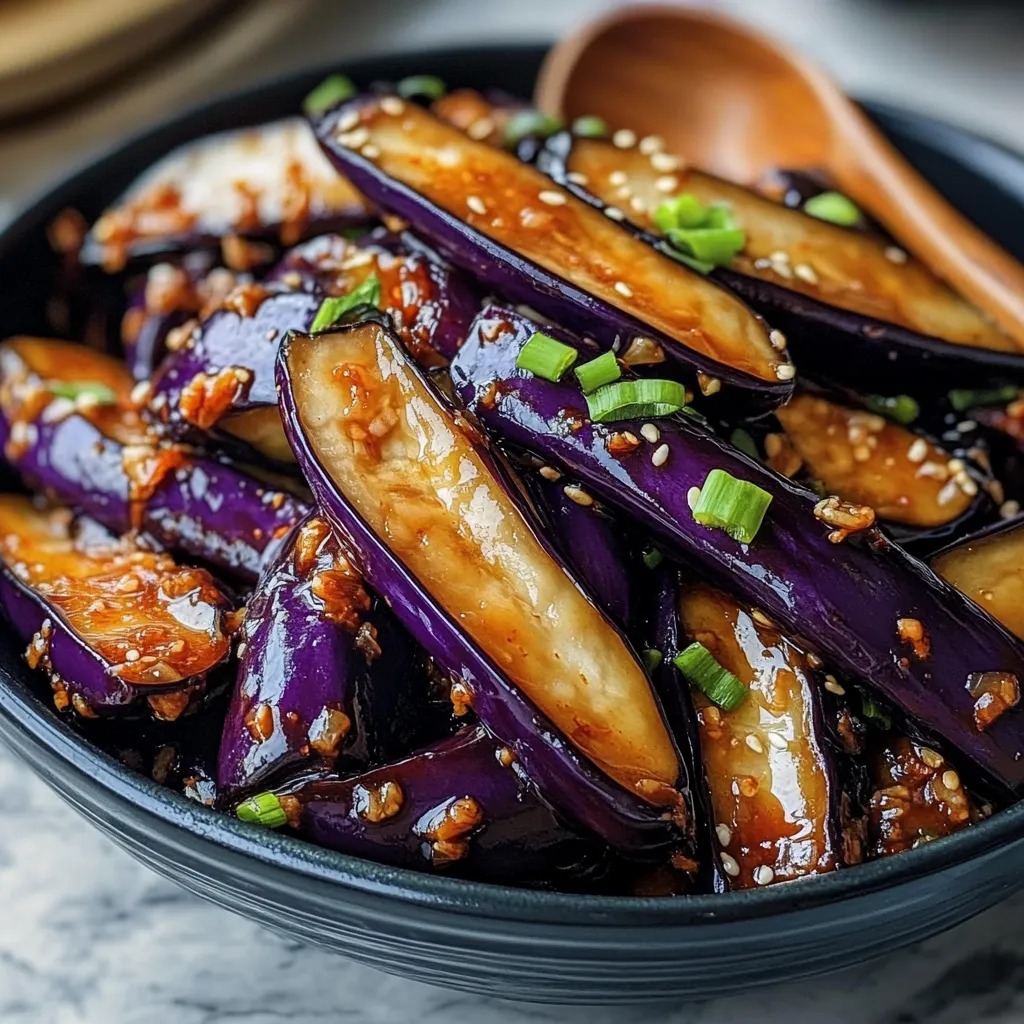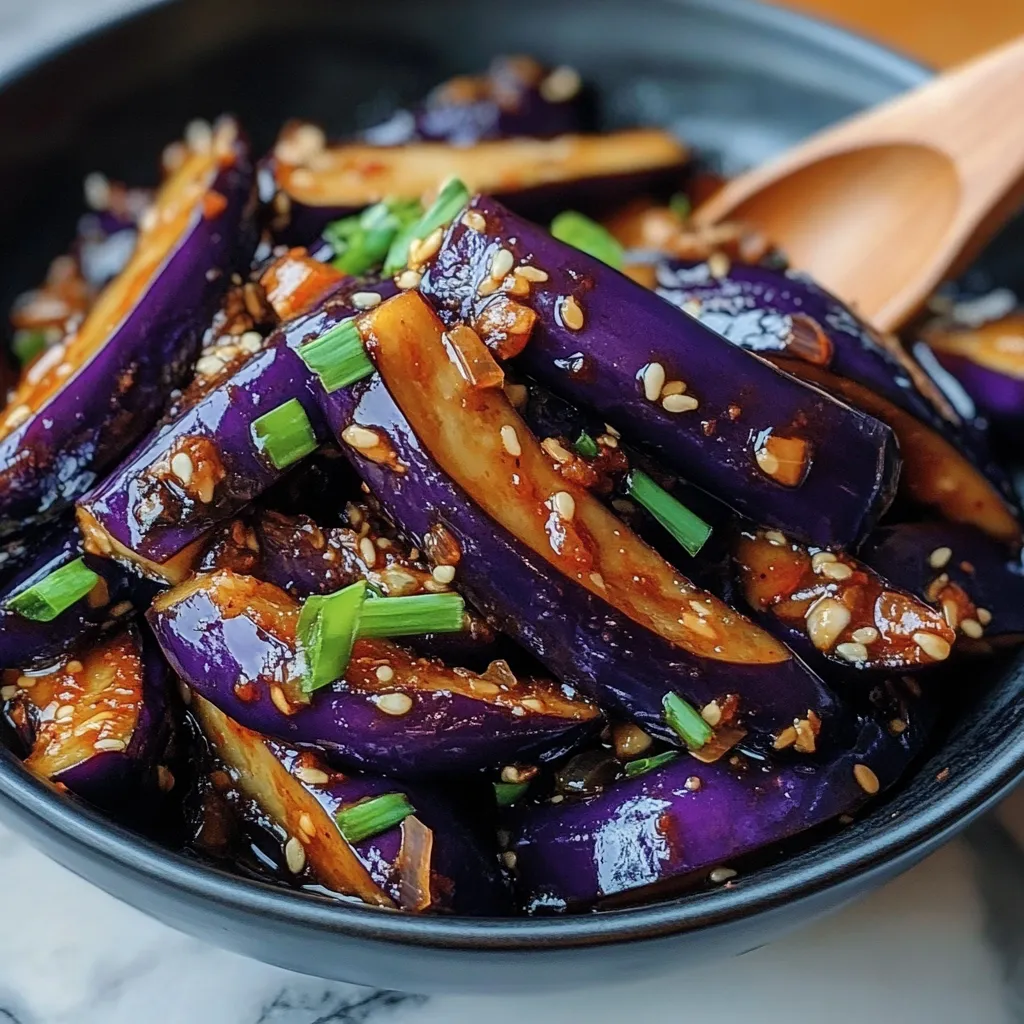I’ll never forget the first time I encountered Chinese eggplant batons swimming in a glossy, spicy garlic sauce. It was at a tiny neighborhood restaurant, where every dish felt like a hug from someone who truly understood the magic of simple ingredients. Years later, I set out to recreate that same experience at home—and let me tell you, nothing beats the sizzle of tender eggplant pieces caramelizing around a garlicky, ginger-spiked sauce. This recipe transforms humble eggplant into a side or light main that’s ready in under 30 minutes, perfect for those evenings when you crave big flavor without hours at the stove.
Unlike its larger globe-shaped cousin, Chinese (or Japanese) eggplant has a thinner skin and a creamier texture when cooked, so it soaks up sauces beautifully without turning to mush. In this stir-fry, a brief salting step helps draw out excess moisture so the eggplant crisps up rather than stews in the pan. Then a handful of aromatics—plenty of garlic, a touch of fresh ginger, and bright scallions—builds the foundation for a sauce that’s tangy, sweet, and just spicy enough. A silky cornstarch slurry brings it all together in a shiny coat that clings to every baton.
Over the years, I’ve perfected this method to require only one skillet (or wok) and a few pantry staples: soy sauce, rice vinegar, chili garlic sauce (or sriracha), brown sugar (or honey), and sesame oil. If you like things milder, simply swap the chili garlic sauce for extra honey; if you crave real heat, add an extra teaspoon—or a dash of crushed red pepper flakes. The result is a versatile crowd-pleaser that’s equally at home alongside steamed rice, tossed with noodles, or served cold as a make-ahead salad.
Whether you’re cooking for two or a family of four, this dish scales beautifully—and it reheats like a dream. On busy weeknights, I’ll double the batch and enjoy leftovers tossed into fried rice or stuffed into warm pita pockets for lunch. Trust me, once you master this quick garlic sauce and eggplant technique, it will become one of your go-to solutions for effortless, flavorful meals.
STEPS
- Prep the Eggplant
Rinse the eggplant batons and pat them very dry. Place them in a large bowl, sprinkle with a pinch of salt, and let sit for 10 minutes. This step draws out excess water, preventing a soggy stir-fry and allowing the edges to brown nicely. After ten minutes, use paper towels to blot away any liquid.

- Cook the Eggplant
Heat 1 tablespoon of vegetable oil in a large nonstick skillet or wok over medium-high heat. Once the oil shimmers, add half of the eggplant pieces in a single layer. Let them sear, stirring occasionally, until they’re golden brown and beginning to soften—about 5–6 minutes. Transfer the browned eggplant to a plate, then repeat the process with the remaining oil and eggplant. - Sauté Aromatics
Reduce the heat to medium. Add the minced garlic and grated ginger directly to the hot pan. Stir constantly for about 30 seconds, just until fragrant—be careful not to let the garlic burn. The aromatic base you create here will infuse the entire sauce with robust, warming flavor.
Building the Sauce and Bringing It All Together
By now, your eggplant is perfectly browned and waiting on the sidelines like a champion athlete about to re-enter the game. The next steps are where the real magic happens: crafting a sauce that’s equal parts sweet, savory, tangy, and just the right amount of heat, then tossing it all together so every baton of eggplant is coated in glossy, garlicky goodness.
STEPS
- Build the Sauce
With the pan still at medium heat, pour in 3 tablespoons of low-sodium soy sauce, 2 tablespoons of rice vinegar, 1 tablespoon of chili garlic sauce (or sriracha if you prefer), and 1 tablespoon of brown sugar or honey. Add 1 teaspoon of sesame oil for that nutty aroma. Stir the mixture well, scraping up any browned bits from the bottom of the pan—that’s pure flavor right there. Bring the sauce to a gentle simmer so the sugar dissolves and the flavors meld, about 1–2 minutes. - Thicken the Sauce
Give your cornstarch slurry (1 teaspoon cornstarch mixed with 2 tablespoons water) a quick stir to recombine any settled starch, then pour it into the simmering sauce. Stir constantly for another 1–2 minutes. You’ll see the sauce transition from thin and runny to a shiny, clingy consistency that’s perfect for coating the eggplant. If it looks too thick, add a splash of water or extra rice vinegar; if it’s too thin, let it cook another thirty seconds. - Toss Eggplant in Sauce
Return the browned eggplant to the skillet. Use a spatula or tongs to gently turn and toss each piece, ensuring every baton is bathed in that sticky garlic sauce. Cook for an additional 2 minutes, just long enough for the eggplant to soak up the flavors and become tender throughout. You want it silky, but not falling apart. - Finish & Garnish
Turn off the heat and sprinkle the sliced scallions over the top. If you’re feeling extra indulgent, drizzle a few drops of sesame oil for added fragrance. Give it a final toss, then transfer everything to a serving platter. The aroma alone will have everyone at the table reaching for their chopsticks.
Tips & Variations
- Adjusting the Heat: If you love fiery dishes, stir in an extra half teaspoon of chili garlic sauce or a pinch of red pepper flakes when building the sauce. For a milder version, reduce the chili garlic sauce to one teaspoon and increase the honey or brown sugar by another teaspoon.
- Sweetness Swap: Feel free to experiment with different sweeteners—maple syrup adds a slightly smoky note, while palm sugar brings a deeper caramel flavor.
- Veggie Boost: For more color and texture, toss in a handful of halved cherry tomatoes or thinly sliced bell peppers right before adding the cornstarch slurry. They’ll soften quickly and add a fresh burst to each bite.
- Protein Pairing: Make this a heartier meal by adding tofu or chicken. After searing the eggplant (step 2), move it to one side of the pan and add cubed tofu or diced chicken to the other side. Cook until golden, then proceed with the aromatics and sauce—both will absorb those flavors beautifully.
- Make-Ahead Friendly: The sauce can be prepared up to a day in advance. Store it in a sealed container in the fridge, then reheat gently and toss with freshly cooked eggplant when you’re ready to serve.
- Nutty Crunch: Sprinkle toasted sesame seeds or chopped peanuts on top just before serving for an extra layer of texture and flavor.

FAQ
1. Can I substitute globe eggplant for Chinese eggplant?
Globe eggplant is more widely available, but its thicker skin and denser flesh won’t caramelize as quickly or hold sauce in quite the same way. If you must, peel the skin in alternating strips, cut into similar-sized batons, and increase the cooking time by a few minutes so it softens fully.
2. My sauce turned out lumpy—what happened?
A lumpy sauce usually means the cornstarch slurry wasn’t mixed thoroughly before adding or the pan wasn’t hot enough to activate it. Always whisk the slurry immediately before pouring it in, then stir constantly over a gentle simmer until the sauce becomes smooth and glossy.
3. How can I make this dish nuttier without using sesame oil?
To introduce deeper nutty notes, toast a tablespoon of sesame seeds or crushed peanuts in the dry pan before you start cooking the eggplant. Remove them, then proceed with the recipe; toss them back in as a finishing garnish for extra crunch and aroma.
4. What’s the best way to reheat leftovers without losing texture?
Reheat gently in a nonstick skillet over medium-low heat, adding a teaspoon of water or rice vinegar if the sauce has thickened too much. Stir frequently to prevent sticking and to revive the eggplant’s tender bite. Avoid the microwave—it tends to steam the pieces and makes them overly soft.
5. Is there a gluten-free version of the sauce?
Absolutely—use tamari or a certified gluten-free soy sauce in place of regular soy sauce. All other ingredients are naturally gluten-free, so you’ll keep the same balance of salty, sweet, and spicy without worry.
6. Can I batch-prep components for meal prep?
Yes. Cook and cool the eggplant separately, and keep the sauce in its own container in the fridge for up to three days. When you’re ready to eat, warm the sauce just until it simmers and toss in the eggplant to coat. Finish with scallions right before serving to maintain color and freshness.
Conclusion
And there you have it—an effortlessly bold and vibrant stir-fry that elevates eggplant from humble to unforgettable in just half an hour. From that initial salting trick that guarantees crisp edges to the silky garlic-ginger sauce that clings to every baton, each step works in harmony to deliver maximum flavor with minimal fuss.
Whether you’re feeding a busy family on a weeknight or crafting a veggie-forward spread for friends, this Chinese eggplant with garlic sauce hits all the right notes: sweet, savory, tangy, and just spicy enough to keep you coming back for more. Feel free to experiment—swap in tofu or chicken for extra protein, add sliced bell peppers for color, or drizzle with extra chili garlic sauce if you crave fire. Whatever path you choose, this recipe will adapt and shine.
Give it a try tonight, and let me know how yours turns out. Did you add a twist of maple syrup? Toss in toasted nuts for crunch? Share your successes and creative tweaks in the comments below—because the best kitchen stories happen when we learn from each other. Happy cooking!
Print
Szechuan-Style Eggplant in Garlic Sauce
- Total Time: 35 min
Description
Tender eggplant bathed in a fiery, garlicky sauce with bold Szechuan flavor—perfect over steamed rice or tossed with noodles for a quick weeknight dinner.
Ingredients
For the Eggplant
-
2 large Chinese (Asian) eggplants (about 1 lb / 450 g), cut into 2” (5 cm) long strips
-
¼ cup (60 ml) vegetable oil, plus extra for drizzling
-
½ tsp salt
For the Sauce
-
2 Tbsp light soy sauce
-
1 Tbsp dark soy sauce
-
1 Tbsp Chinese black vinegar (or rice vinegar)
-
1 Tbsp Shaoxing wine (or dry sherry)
-
1 Tbsp chili bean paste (doubanjiang)
-
1 tsp sugar
-
1 tsp cornstarch
-
2 Tbsp water
Aromatics & Finishing
-
4 cloves garlic, finely minced
-
1 Tbsp fresh ginger, finely minced
-
2 scallions (green onions), white and green parts separated and thinly sliced
-
1 tsp Szechuan peppercorns, toasted and roughly crushed (optional but authentic)
-
1 tsp toasted sesame oil
-
1 Tbsp toasted sesame seeds
-
Fresh cilantro leaves, for garnish (optional)
Instructions
1️⃣ Salt & sweat the eggplant
: Place eggplant strips in a colander, sprinkle with ½ tsp salt, and let sit 10 minutes to draw out bitterness. Rinse briefly, pat dry, and set aside.
2️⃣ Mix the sauce
: In a small bowl, whisk together both soy sauces, black vinegar, Shaoxing wine, chili bean paste, sugar, cornstarch, and water. Set aside.
3️⃣ Pan-fry the eggplant
: Heat ¼ cup oil in a large skillet or wok over medium-high heat until shimmering. Add eggplant in batches (avoid overcrowding) and fry, stirring gently, until soft and golden—about 5–6 minutes. Transfer to a plate lined with paper towels to drain excess oil.
4️⃣ Toast the peppercorns (if using)
: Wipe out excess oil from the skillet, leaving just a thin film. Add Szechuan peppercorns and toast 30 seconds until fragrant; remove and set aside.
5️⃣ Sauté aromatics
: In the same skillet, add garlic, ginger, and the white parts of the scallions. Stir-fry 30 seconds until aromatic.
6️⃣ Build the sauce
: Give the sauce mixture a quick whisk, then pour into the pan. Stir constantly until the sauce thickens and glazes the pan, about 1 minute.
7️⃣ Combine & finish
: Return the fried eggplant (and toasted peppercorns) to the skillet. Toss gently to coat every piece in the sauce. Drizzle with sesame oil, then stir in the green scallion slices.
8️⃣ Garnish & serve
: Transfer to a serving dish. Sprinkle with sesame seeds and cilantro leaves if desired. Serve immediately with steamed rice or your favorite noodles.
Notes
-
Less oil method: Roast or air-fry the eggplant strips at 400 °F (200 °C) for 12–15 minutes, then proceed with sauce in the pan.
-
Vegetable add-in: Stir in sliced bell peppers or snow peas along with the eggplant.
-
Heat level: Increase doubanjiang or add sliced fresh chilies to the aromatics for extra kick.
-
Protein boost: Toss in cubed tofu or cooked ground pork when you return the eggplant to the pan.
-
Make-ahead: Fry the eggplant and prepare the sauce mixture up to 1 day ahead; assemble just before serving.
- Prep Time: 10 min
- Cook Time: 15 min









